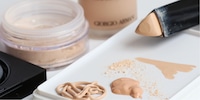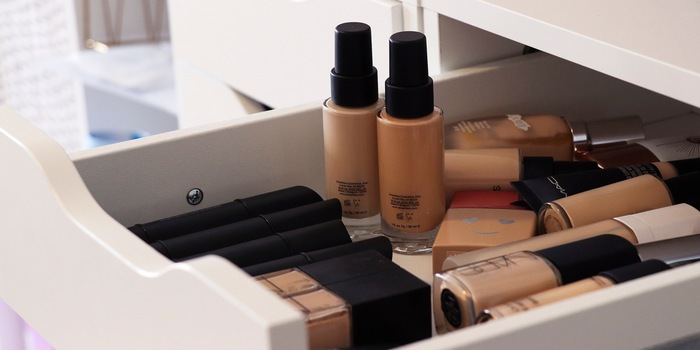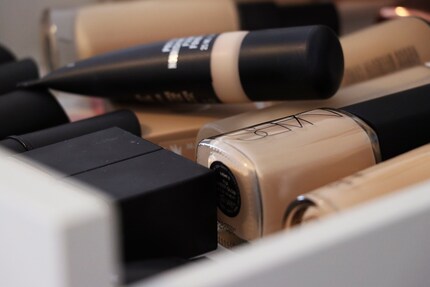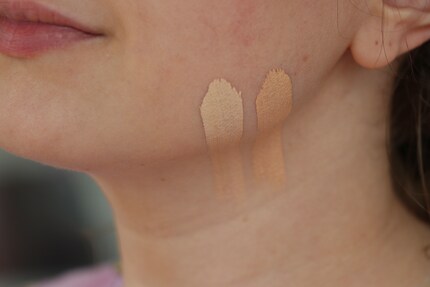
Guide
Cushion, stick and everything in between: which foundation is right for you?
by Natalie Hemengül

"Can you recommend a good foundation?" is the beauty question I'm most often asked. It's also a question I can't answer so easily. I'll explain it all here.
Re-ordering your favourite foundation is no big deal. On the other hand, finding one that suits you and your needs can sometimes be a challenge. Especially if you shop online. I'd even go so far as to say that this is an exercise reserved for professionals. Unless you have a playful spirit. To find the right shade at a glance on the Internet, you need two things: firstly, a good knowledge of your skin tone, but also a faithful rendering of the colours on the product images. Most of the time, neither of these things is present. I therefore recommend that you don't make your first online purchase blindly, but take the time for a face-to-face consultation at the counter. I hope these few tips help you find the perfect foundation to suit all your needs.
You can already start by asking yourself the following questions: how do you want the foundation to look on your skin and how important is coverage to you? This will already help you narrow down the choice.
Mat:
people with oily-prone skin generally look for a mattifying foundation. This type of foundation generally offers good coverage and long-lasting hold. The downside: your features are erased and your face can appear flat, without relief. Self-tanning, highlighter and blush are therefore essential after applying such a foundation. [[productlist:10040415]]
Glossy: foundations with a glossy (or "glowy") finish look more natural on the skin, as they reflect light better on prominent areas, such as the cheeks. They also have moisturising properties, making them particularly suitable for dry skin. They offer light to medium coverage. The skin looks healthier because its texture is visible. For long-lasting hold, it's best to apply a setting powder after foundation and touch up a few times throughout the day. [[productlist:10680076]]
Satin: a satin texture actually gives a semi-matte appearance to the skin. It is therefore a compromise between matte and shiny, or in other words, it makes the skin silky. Coverage varies greatly from one product to another, but they are generally easy to apply. So you can easily apply several coats on top of each other until you get the coverage you want. [[productlist:6885613]]

Once you know what you want from a foundation, you can start looking for your shade - this is called 'colour matching'. This means finding a foundation that matches the colour of your neck, not your face. It may sound strange, but it's quite logical when you think about it: the skin colour of your body and neck rarely matches that of your face. If you opt for a foundation that only matches your face, you'll inevitably have unsightly makeup lines along your jawline.
To do this, it's essential to know your skin tone: cool, neutral, warm or olive.
If gold jewellery suits you better than silver, the veins on your wrists are olive green, your skin looks yellow in daylight and you quickly turn colour when exposed to the sun, you probably have a warm complexion. Opt for a foundation with yellow or golden undertones.
If silver suits you better than gold, the veins on your wrists are bluish or even purple, and you sunburn quickly, you have a cool complexion. Pink spots on your face can also be a good indicator. Opt for a foundation with pink undertones.
If gold and silver jewellery look equally good on you and the veins on your wrists are a bluish green, you often have a neutral complexion. This means that your skin maintains a balance between warm and cool tones. This gives you greater freedom when choosing your foundation.
If you can wear gold and silver jewellery and your skin sometimes looks pale or pallid, you certainly have an olive complexion. In that case, opt for a foundation with subtle golden undertones and avoid yellow shades for make-up.
The different shades are numbered and usually accompanied by a letter w, c or n, when the shade is not clearly explained. The letters stand for "warm", "cool" and "neutral" respectively. Olive is rarely mentioned.
Once you've been through our range and made a shortlist, you can get down to the nitty-gritty. Apply the different candidates side by side at your jawline, making sure the foundation starts from your face, goes over the bone and down your neck. This way, you can quickly work out which colour works best with the colour of your neck. If you're struggling to find the perfect shade, try mixing two shades.

Have a professional apply the "winner", then step out into the sun briefly with a small mirror. The shades often look completely different in daylight. If you still like the look, congratulations, you've found your foundation. You can also ask for a sample. This will allow you to test the product at home, with your own tools and brushes (article in German) and make sure you're not allergic to it. Also bear in mind that many foundations oxidise, meaning they darken after drying. So a foundation that was perfectly fine just after application can look far too dark or orange a few minutes later.
Find all our foundations here.
As a massive Disney fan, I see the world through rose-tinted glasses. I worship series from the 90s and consider mermaids a religion. When I’m not dancing in glitter rain, I’m either hanging out at pyjama parties or sitting at my make-up table. P.S. I love you, bacon, garlic and onions.
Practical solutions for everyday problems with technology, household hacks and much more.
Show all